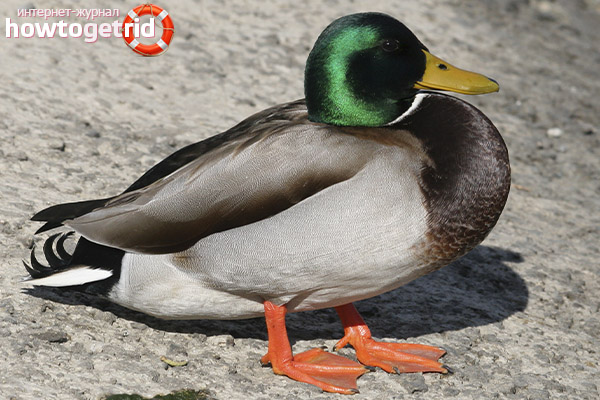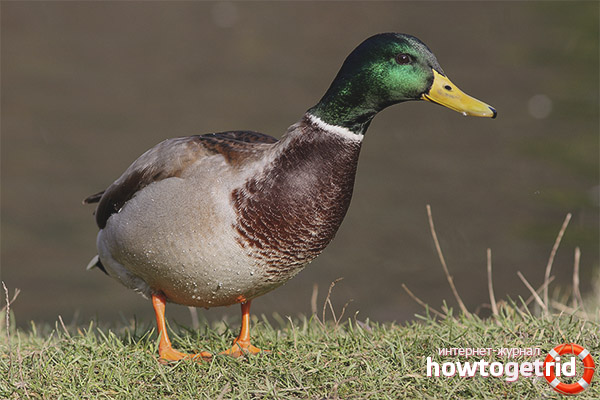The content of the article
Mallard is the most famous bird among ducks. According to the classification of species, mallard is part of the order of Anseriformes, but it is customary to rank it among the duck family.
Appearance
Outwardly, the mallard is a rather dense and well-fed duck. These birds have a very small tail, but the head is quite impressive. Mallard can reach 60 centimeters in length, small birds have a length of about 40 centimeters. The wingspan of these individuals reaches one meter. One wing has an average length of about 30 centimeters. Mallard's body weight is approximately 1.5 kilograms.
The beak, as traditionally with ducks, is quite wide and flat. In representatives of the sexes, the shade of the beak is different, so it is easy to determine the gender by it. Males, as a rule, get a beak, the base of which has a greenish tint, but closer to the end it changes to yellow. In older males, beaks can occur without overflows of an orange hue or the color of olives. In females, the beak is quite unusual, at the base on it you can see black specks.
Females do not differ in such complex plumage as males. In most cases, their color can be found in gray, brown and red shades. They are traditionally placed on the back and wings. On the breast, feathers are painted in ocher, the legs have a dull orange color.
Where do they live?
Mallards are mainly distributed in the northern hemisphere. In our country they can be found in the Tundra. If you take Europe, then they are found there quite often, you can’t find them only in the highlands. Such wild ducks are partly migratory. For example, those individuals that live in Greenland do not fly away for the winter, because the climate there is suitable for nesting. From Russia, ducks traditionally migrate to Turkey and the Mediterranean Sea. In the Himalayas, mallards simply descend to wait out the winter time.
In general, mallards prefer to live in forest-steppe stripes. They can reside in both fresh and salt water. These ducks do not really like rivers and other bodies of water that have a fast current. In addition, mallards do not settle near lakes, which have very poor flora and fauna.
As soon as the time comes to equip their nests, mallards find ponds with stagnant water, as cane and sedge grow in large numbers in them.
What do they eat?
Mallards eat quite varied; they are not whimsical in food. Each meal can be compared to a filtering process. In the beak, these ducks have special plates that can separate plants, as well as aquatic animals. Mallards calmly eat fish, tadpoles, insects and even frogs.
Near ponds, one can sometimes find an unusual picture when a duck immerses its head and body in water, leaving only a protruding tail outside. This phenomenon means that the mallard is trying to get aquatic plants that grow at the bottom.
How does molting occur?
A distinctive feature of mallards in comparison with other species of birds is molting, which is carried out as much as twice a year. This phenomenon accompanies mallards before nesting and at the end of the breeding season. As soon as the females begin to hatch eggs, the males begin to change their plumage. In females, molting begins after the chicks begin to make their first flights. If the female during the mating season was left without a couple or she did not have an egg laying, the process of molting will begin at the same time as that of the males. To change the plumage, mallards usually leave the house for the steppe.
How does reproduction occur?

Puberty in ducks occurs at the age of one year. From this moment on, mallards can already fully reproduce. As a rule, if the ducks do not migrate, then in the fall they begin to look for a mate. The rest do this after a flight to warm regions. More often in flocks the number of males is much larger than the number of females. This is due to the fact that females often die during the hatching period. It is this fact that makes males participate in the real struggle for females, as well as for the opportunity to continue their race. To show the female their best qualities, males use certain mating rituals.
First, the drake neatly swims to the female, dropping its beak down. Then it very sharply and with great expression takes the beak up several times, the whole process is accompanied by splashes. If he really liked the female, then the male begins to hide the beak under the wing, accompanying this action with traditional sounds. If the female also liked the drake, she swims around him for several laps, while nodding her head. After this, the formed pair is removed to a secluded place, where mating takes place.
Traditionally, the spleen is present next to its half, only until it lays eggs. Then he adjoins other males and flies with them into the steppe for molting.
Nest arrangement
After hatching from eggs, the chicks have fluff of an olive or creamy hue on their bodies. In order to start running, diving and swimming, kids need only 20 hours. After that, they begin to eat on their own, looking for insects.
Video: Mallard (wild river duck)











Submit